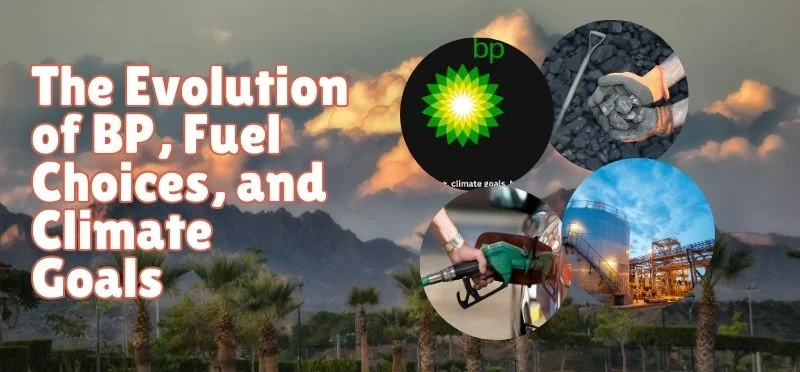BP (British Petroleum) has long been a significant player in the global energy market. As the world grapples with climate change and seeks sustainable solutions, BP’s strategies and product offerings are evolving. This article delves into BP’s growth, the role of gasoline, and how fuel choices impact climate goals, focusing on how these elements interconnect.
BP, originally known as the Anglo-Persian Oil Company, was founded in 1909 and has since grown into one of the largest and most influential energy companies in the world. The company’s journey is a reflection of the broader history of the energy sector, marked by periods of rapid expansion, technological innovation, and significant challenges. Over the decades, BP has adapted to changing economic conditions, regulatory environments, and societal expectations, consistently positioning itself at the forefront of the industry.
BP’s Strategic Growth and Development
BP’s strategic growth and development are deeply rooted in its historical background, marked by its inception as the Anglo-Persian Oil Company in 1909 and its subsequent rebranding to British Petroleum in 1954. The company’s journey from discovering vast oil reserves in Persia to becoming a global energy giant showcases its ability to adapt and thrive in an evolving market. Modern expansion and innovation have played crucial roles in BP’s strategy, particularly in response to the 1970s oil crises, which led to diversification into natural gas and renewable energy sources. Financially, BP has demonstrated resilience and strong performance through strategic mergers, such as those with Amoco and ARCO, enhancing its market position and operational capabilities. Today, BP’s commitment to sustainability and investment in cutting-edge technologies reflect its ongoing evolution, aiming to balance profitability with environmental responsibility.
Read also: Ed sheeran details the lovestruck jitters in sweet new single : A Track-by-Track Breakdown
Historical Background
BP’s journey began over a century ago. Established in 1909, BP has grown from a small oil exploration company into one of the world’s largest energy providers. The company’s history is marked by significant milestones, including the discovery of vast oil fields and the expansion into various energy sectors. During the mid-20th century, BP continued to grow, capitalizing on the increasing global demand for oil. The post-World War II economic boom saw a surge in oil consumption, further solidifying BP’s position in the market. In 1954, the company rebranded as British Petroleum, reflecting its growing international presence and ambitions.
Modern Expansion and Innovation
In recent years, BP has embraced innovation and sustainability. The company’s strategic growth involves investing heavily in renewable energy sources, such as wind and solar power. BP aims to reduce its carbon footprint and transition to a more sustainable energy model, aligning with global climate goals.
Financial Performance and Market Position
BP’s financial performance is a testament to its growth strategy. Despite market fluctuations, BP continues to report strong earnings, driven by a diversified energy portfolio. The company’s ability to adapt to changing market dynamics ensures its leadership position in the energy sector.
Read also: Adescarger: Comprehensive guide for Fast and Secure Downloads
The Role of Gasoline in Today’s Energy Landscape
BP’s strategic growth and development are intricately tied to the evolving dynamics of gasoline consumption. Historically, gasoline has been the lifeblood of global transportation, driving economic growth and urbanization. However, current trends indicate a shift towards more sustainable energy sources, spurred by increasing environmental awareness and regulatory pressures. The environmental impact of gasoline, primarily its contribution to greenhouse gas emissions and air pollution, has necessitated a reevaluation of traditional fuel paradigms. In response, BP has committed to developing cleaner fuel alternatives and investing in renewable energy projects, positioning itself as a leader in the transition to a low-carbon economy. This strategic pivot not only addresses the immediate environmental concerns but also aligns with the long-term global climate goals, ensuring BP’s continued relevance and competitiveness in the future energy landscape.
Gasoline: A Historical Perspective
Gasoline has been the backbone of global transportation for over a century. Its widespread use and relatively low cost have made it the preferred fuel for millions of vehicles worldwide. However, the environmental impact of gasoline consumption is a growing concern.
Read also: Sportsgurupro.com Task Offers- App Login, Earning Tips & Feature | Fintechzoom Facebook Stock
Current Trends in Gasoline Consumption
Today, gasoline consumption patterns are shifting. Increasing awareness of environmental issues and advancements in technology are driving changes in how gasoline is produced and used. BP is at the forefront of developing cleaner gasoline alternatives and improving fuel efficiency.
Environmental Impact of Gasoline
The environmental impact of gasoline cannot be overlooked. Combustion of gasoline releases significant amounts of carbon dioxide (CO2), a major greenhouse gas contributing to global warming. Additionally, gasoline engines emit pollutants such as nitrogen oxides (NOx) and particulate matter, which can harm air quality and public health.
Reas also: www.mygkguru.in | Puppy:iuuiiqqqwao= Dogs
BP’s Commitment to Sustainable Fuel Choices
BP is steadfast in its commitment to sustainable fuel choices, demonstrated through substantial investments in renewable energy, the development of cleaner fuels, and strategic partnerships and collaborations. The company is channeling significant resources into renewable energy projects such as wind and solar power, aiming to reduce reliance on fossil fuels and lower carbon emissions. Concurrently, BP is pioneering advanced biofuels and synthetic fuels that promise to cut emissions from traditional internal combustion engines, thereby minimizing environmental impact. Additionally, BP’s collaborations with industry leaders, governments, and research institutions are crucial in driving innovation and accelerating the transition to a low-carbon economy, ensuring a sustainable and resilient energy future.
Investment in Renewable Energy
BP is heavily investing in renewable energy projects. The company aims to become a net-zero emissions business by 2050. Investments in wind, solar, and biofuels are crucial components of BP’s strategy to reduce reliance on fossil fuels and lower its carbon footprint.
Read also: 127.0.0.1:49342 in Localhost Connections : A Comprehensive Guide to Using and Configuring
Development of Cleaner Fuels
In addition to renewable energy, BP is focused on developing cleaner fuels. This includes advanced biofuels and synthetic fuels that can reduce emissions from existing internal combustion engines. By improving fuel quality and efficiency, BP is working to minimize the environmental impact of its products.
Partnerships and Collaborations
BP’s commitment to sustainability extends to partnerships and collaborations with other industry leaders, governments, and research institutions. These alliances are essential for driving innovation and accelerating the transition to a low-carbon economy.
Challenges and Opportunities in Achieving Climate Goals
Government regulations and policies play a crucial role in shaping the energy sector. BP must navigate a complex landscape of environmental regulations, emissions standards, and climate policies. Staying ahead of regulatory changes is vital for maintaining compliance and achieving sustainability targets.
Technological Innovations
Advancements in technology are creating new opportunities for BP. Innovations in renewable energy, energy storage, and carbon capture and storage (CCS) are key to reducing emissions and enhancing energy efficiency. BP’s investment in research and development is driving progress in these areas.
Read Also: Ontpress Com Secure Your Finances Futures with https://ontpress.com
Market Dynamics and Consumer Behavior
Shifts in market dynamics and consumer behavior also impact BP’s strategy. As consumers become more environmentally conscious, demand for cleaner energy sources is increasing. BP must adapt to these changes by offering sustainable products and services that meet evolving customer needs.
Conclusion
BP’s growth and development, the evolving role of gasoline, and the pursuit of climate goals are deeply interconnected. By investing in renewable energy, developing cleaner fuels, and leveraging technological innovations, BP is positioning itself as a leader in the transition to a sustainable energy future. The challenges are significant, but the opportunities for positive impact are even greater.



